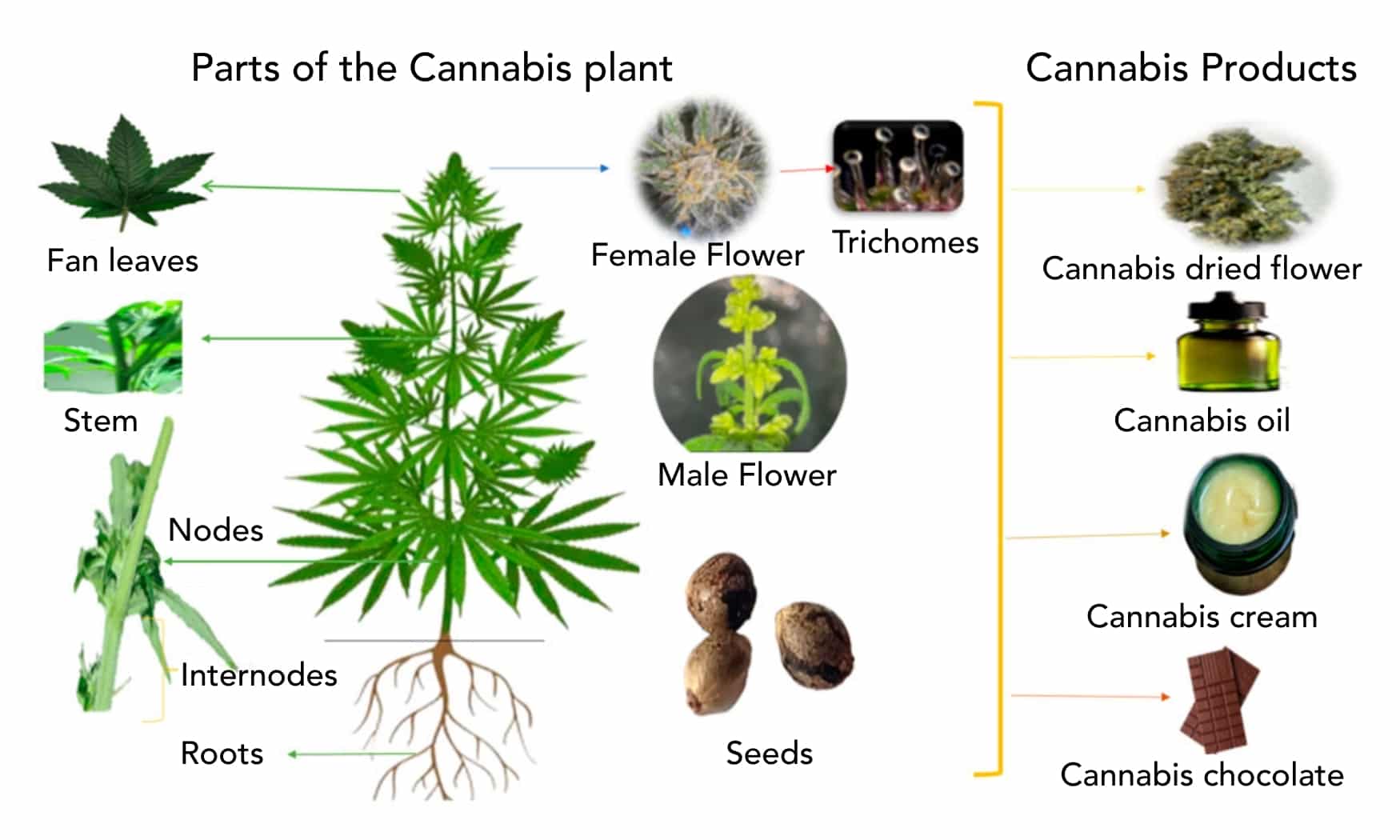Skip To Section
Marijuana is the most commonly used drug in the United States, after alcohol. Seventy-eight million people—almost half the population—have reported using marijuana at some point in their lives. Thirty-five million Americans say they use marijuana on a monthly basis. As the popularity of marijuana grows, so does its acceptability in society. With so many people using this drug, it’s hard not to wonder: Do they know what they’re putting in their bodies? Learn more about marijuana facts: what it looks like, what it smells like, how long marijuana stays in your system, and more.

What Is Marijuana?
Marijuana, sometimes referred to as weed, pot, grass,or ganja, comes from the cannabis plant. The cannabis plant is green and leafy, with trichomes (tiny hairs) that grow on the stems and leaves. The cannabis plant is similar to both the okra and the cassava plant.
Cannabis is a flowering plant that contains the mind-altering chemical THC. This chemical is responsible for the intoxicating effects people often seek when using marijuana.
To consume marijuana, the leaves and flowers of the cannabis plant must first be dried. This results in dark, greenish-gray clusters. Once dried, marijuana can be smoked or ingested in other ways.
Marijuana is typically smoked as a cigarette (or “joint”), or through a pipe. It can also be consumed orally by baking it into food or boiling it as tea.
The Difference Between Marijuana (THC) and CBD
You have probably heard of CBD. It’s gained huge popularity in the past several years. Cannabidiol (CBD) is one of the two major compounds found in marijuana; the other being tetrahydrocannabinol (THC). Because they both come from the same plant, people sometimes mix them up, but they are very different. CBD is non-psychoactive, meaning it won’t get you “high.” It has been shown to offer a range of medicinal benefits, from anti-anxiety to anti-inflammatory properties. CBD is most commonly found as an oil, which can be ingested or used topically. The THC found in marijuana is also used medicinally, but with it comes a “high,” since THC is a psychoactive compound.
"*" indicates required fields
Fill out the form below and one of our admissions team members will reach out to you:
"*" indicates required fields
A Brief History of Marijuana
Marijuana was discovered in Central Asia around 500 B.C. Marijuana made it to the Americas in the mid-1500s, brought by the Spanish. Historically, people considered marijuana an herbal medicine and not a drug. In fact, in the 1800s cannabis was available in doctors’ offices and pharmacies to treat stomach problems and other conditions. In the early 1900s, The Food and Drug Act required any product containing cannabis to have a contents label. Throughout the next several decades, marijuana regulations and restrictions continued to emerge. Yet it was not until 1970 that Congress passed the Controlled Substances Act, which named marijuana a Schedule I drug.
How Does Marijuana Affect the Brain and Body?
Although marijuana has been—and continues to be—used medicinally, it is not without some negative effects. Marijuana use has a direct effect on the brain. Short-term use can impact:
- Attention
- Memory
- Decision-making abilities
Marijuana also affects the development of the brain. That development is ongoing until age 25, so for adolescents and teenagers whose brains are still growing, marijuana use is especially impactful. Long-term use can affect how the brain builds connections in the areas responsible for learning and concentration.
Other effects include:
- Euphoric feeling
- Laughter
- Increased appetite
- Altered perception of time
- Relaxation
- Paranoia
- Lack of coordination
- Delayed reaction time
How Long Does Marijuana Stay in Your System?
Like most drugs, the length of time marijuana stays in your system varies based on many factors. Some things that affect how long marijuana stays in the system include:
- THC levels in the marijuana used
- Your level of hydration
- Your metabolism
- How frequently you use marijuana
There are numerous ways to test for marijuana. Hair samples can typically detect any marijuana use in the past 90 days, while a blood test can only identify any use in the past 36 hours. Urine samples are also often used to test for marijuana. Urine tests can detect marijuana use anywhere from 3 to 30 days after use, depending on the level of use.
Can You Overdose on Marijuana?
It is possible to overdose on marijuana, although the overdose is not likely to be fatal. The amount of marijuana consumed to reach the point of overdose is unclear. Yet when marijuana is taken in excessive amounts, it can lead to:
- Vomiting
- Heart arrhythmia
- Hallucinations
- Paranoia
How to Know If You Are Addicted to Marijuana
Marijuana is not physically addictive in the same way as other drugs, like alcohol or cocaine. Still, the psychological addiction of marijuana can be powerful. Because there are no obvious physical indications of marijuana addiction, it can be hard to spot. Those dealing with a marijuana addiction may:
- Give up previously enjoyed activities in favor of using marijuana
- Try to quit using pot and fail
- Use marijuana even when it negatively impacts school, work, and/or home life
Marijuana Treatment Options
If you use marijuana and find that it’s disrupting your life and your responsibilities, treatment for marijuana addiction can make stopping much more successful. While some people can quit on their own, the majority of people need support. And there are lots of options for treatment of a marijuana addiction.
Detoxing from marijuana is the first step to getting clean. Stopping cold turkey can be pretty uncomfortable (especially for long-time users), although not life-threatening. Marijuana withdrawal symptoms can include:
- Increased irritability
- Difficulty sleeping
- Anxiety
- Changes in appetite
- Mood swings
- Restlessness
- Depression
When you choose medical detox from marijuana, you’ll do it in an inpatient setting, where you have 24/7 support from medical staff and counselors.
After detoxing, you may choose to continue your journey with residential marijuana treatment, which can last from a month to a year, depending on your experience with addiction. In a residential program, you’re required to live at a treatment facility. This allows you to completely focus on healing and recovery.
Outpatient treatment is another option and can take many forms. You may find basic outpatient care is sufficient for you, or a more structured intensive outpatient program could be the best choice. Intensive outpatient programs usually meet three to five times a week and consist of both group and individual therapy.
Both inpatient and outpatient programs use some common approaches and interventions in the treatment of marijuana addiction, including:
- Psychoeducation on marijuana addiction
- Individual therapy
- Family education and therapy
- 12-step groups
Cognitive behavioral therapy (CBT) is well-known for its effectiveness in preventing relapse in those recovering from marijuana addiction, and it’s often implemented in marijuana treatment.
Currently, there are no approved medications specifically for marijuana addiction. That said, some people addicted to marijuana may benefit from medication if they were using marijuana as a way to “self-medicate.” It is not uncommon for those with mental health issues, like depression or anxiety, to use a substance as a way to deal with uncomfortable symptoms. But using marijuana (or any other substance) in this way is not effective in actually treating the mental health issue; it just helps cover up or numb the symptoms in the short-term.
If you or someone you know is struggling with marijuana use, contact Footprints to Recovery to find out about treatment options.
- Marijuana Addiction Statistics [2023]: Usage & Abuse Rates
- Cannabis (Marijuana) and Cannabinoids: What You Need To Know | NCCIH
- Cannabidiol (CBD): What we know and what we don’t – Harvard Health
- Marijuana – Plant, Use & Effects | HISTORY
- History of Marijuana
- Pure Food and Drug Act of 1906 and the Start of the Second Prohibition
- How Long Does Weed (Marijuana) Stay in Your System?
- The Controlled Substances Act
- Understanding Your Risk for Cannabis Use Disorder
- Drug Overdose Signs and Treatment
- Principles of Drug Addiction Treatment: A Research-Based Guide (Third Edition)
Our admissions team is available 24/7 to listen to your story and help you get started with the next steps.



